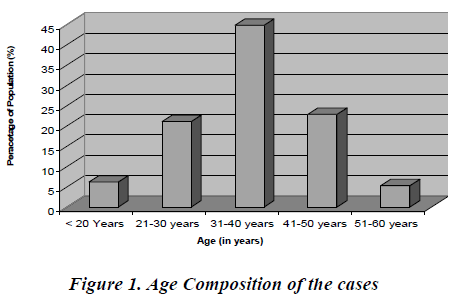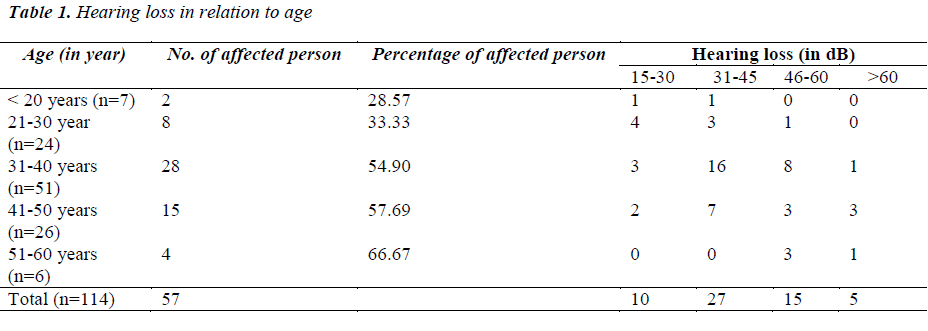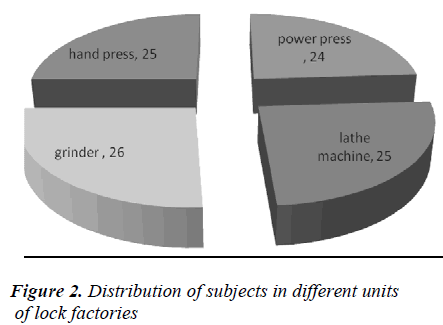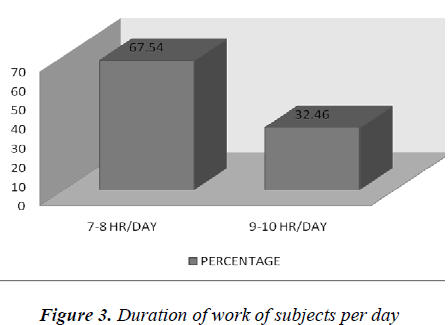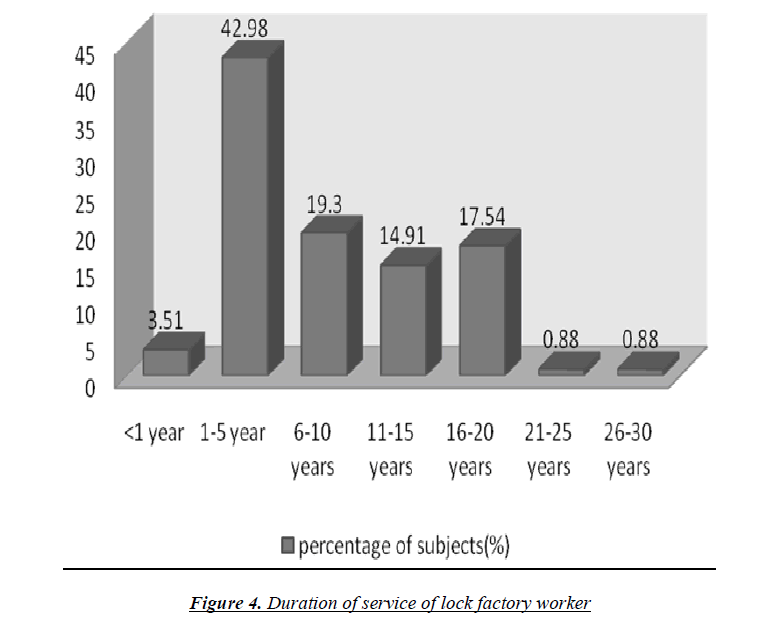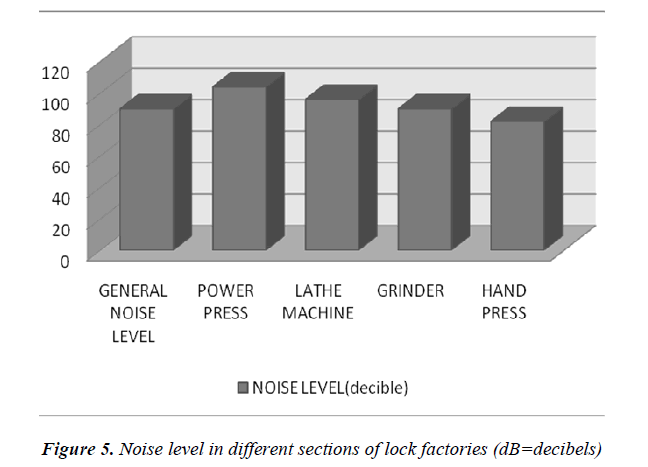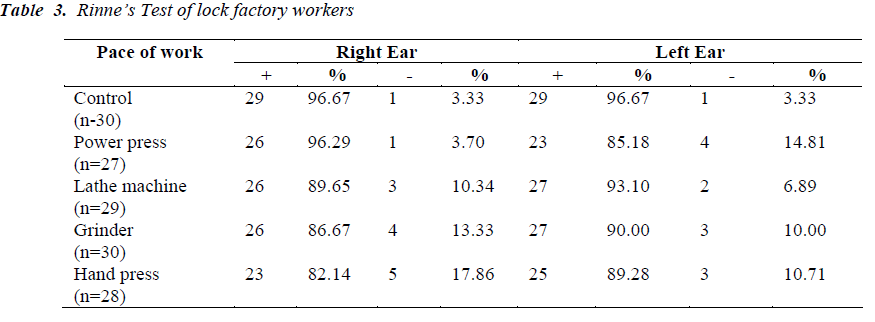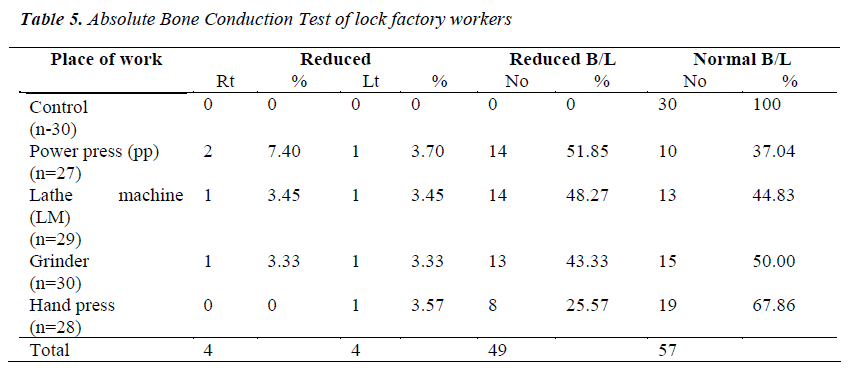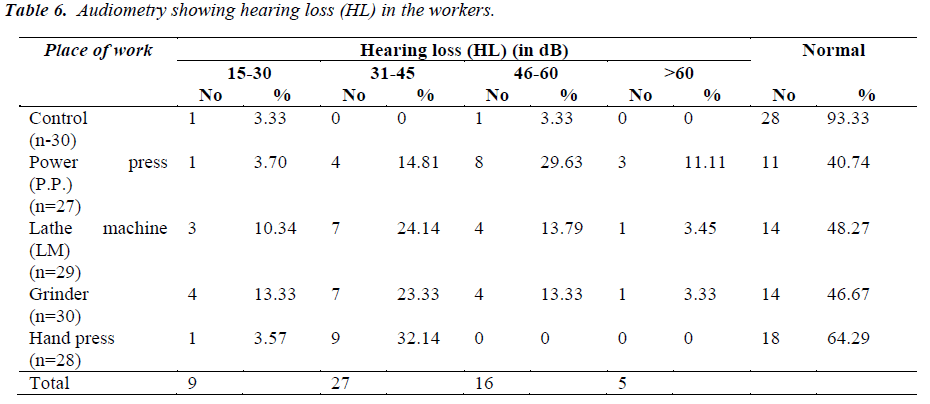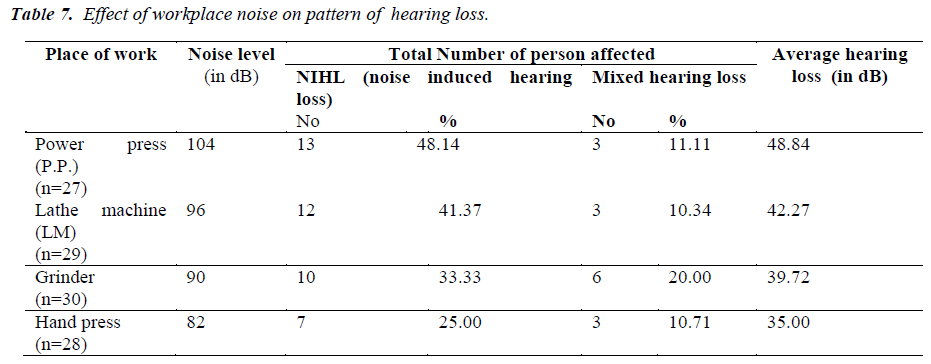- Biomedical Research (2012) Volume 23, Issue 3
Study of occupational exposure of noise on hearing in lock factory workers.
Sangeeta Singhal*, B.K. Yadav, S.F. Hashmi1 and Md. Muzammil2Department of Physiology, J.N. Medical College, Aligarh Muslim University, Aligarh, India
1Department of Otorhinolaryngology, J. N. Medical College, Aligarh Muslim University, Aligarh, India
2Department of Mechanical Engg., Z.H. Engineering College, Aligarh Muslim University, Aligarh, India
- *Corresponding Author:
- Sangeeta Singhal
Department of Physiology
J.N. Medical College
Aligarh Muslim University
Aligarh 202002 (UP)
India
Accepted date: January 07 2012
Abstract
Noise induced hearing loss is the commonest occupational health hazard next only to accidents .Objectives of the present study were to study the characteristics of hearing loss and assess the prevalence of hearing loss in workers of lock factories. The study group included 114 workers employed in different sections of lock factories namely Power press, Lathe machine, Grinder and Hand press units. Fairly high and potentially damaging noise levels were recorded in all the sections of lock factories. Various hearing tests and audiometric test were performed to assess the hearing loss. Result of the present study indicates that hearing impairment are commoner in workers continuously exposed to high levels of occupational noise.
Keywords
Occupational noise, hearing tests, audiometry.
Introduction
The perception of sounds in day to day life is of major importance for human well being. Communication through speech, sound from playing children, music, natural sounds in parks and gardens are all examples of sounds, essential for satisfaction in everyday life. On other hand noise is defined as “unwanted sound” but this definition is subjective because of the fact that one man’s sound may be another man’s noise. Some authors have defined noise as any audible acoustic energy that adversely affects the physiological or psychological well being of the people [1]. The term noise is commonly used to describe sounds that are disagreeable or unpleasant produced by acoustic waves of random intensities and frequencies [2].
Noise pollution is gaining epidemic proportions. The term “Noise Pollution” has been recently coined to signify the vast cacophony of sounds that are being produced in the modern life, leading to health hazards. The 20th century has been described as the “century of noise”. Noise is present in every human activity, and when assessing its impact on human well being it is usually classified either as occupational noise (i.e. noise in the workplace), or as environmental noise, which includes noise in all other setting, whether at the community, residential, or domestic level (e.g. traffic, playgrounds, sports, music).
Hearing loss has become number one disability in the world; around 500 million people worldwide suffer from some form of hearing loss. About 1-2 per 1000 children across the world are born with hearing impairment. In India, the figure is likely to be 3-4 children per 1000. Out of the total deaf population of 6.3% in India, about 1% suffers from noise induced deafness (The Times of India, 24th September 2007). Prevalence of noise is implicated in various illness of human and it is responsible for increased morbidity associated with modern life style. Sound produces not only auditory side effects but also related to non-auditory side effects [3]. Noise is pervasive and ubiquitous hazard in many workplaces. Millions of people are at risk for developing noise induced hearing loss, which is the main effect of noise on health. Occupations at highest risk for noise induced hearing loss include those in manufacturing, transportation, mining, construction, agriculture and the military.
Noise induced hearing loss (NIHL) is one of the most common occupational disease and the second most self reported occupational illness or injury. NIHL is the second most common form of sensorineural hearing deficit after presbyacusis [4].
Noise induced hearing loss is hearing loss caused by either a onetime exposure to very loud sound or by repeated exposure to sound at various loudness levels over an extended period of time. Hearing loss may occur as either temporary threshold shift (when hair cells in the inner ear are able to recover) or after a longer or more intense exposure, as permanent damage from loss of hair cells in the inner ear.
Occupational hearing loss is usually defined as a hearing impairment in one or both ears, partial or complete, arising in, during the cause of, but as the result of one’s employment. More over the gradual loss of hearing which occurs over a long period of time from intense noise is referred to as noise induced hearing loss [5]. Acoustic trauma, a related condition, results from an acute exposure to short term impulsive noise.
Excessive noise pollution has been blamed not only for hearing damage and community annoyance but also for hypertension, fatigue, heart trouble, serum lipid, triglycerides, platelet count, plasma viscosity, glucose and reduced motor efficiency [6,7]. In our country there are large numbers of people who are not aware of the adverse effects of noise. Without doubt, noise is the single most important cause for preventable hearing loss in this world today. The economic burden owed to noise induced hearing loss is tremendous and has been estimated to be billion of dollars. The condition further aggravates with the dependence of these socially handicapped people. So the aim of the present study was to assess the prevalence and characteristics of the hearing loss in people working in noisy surroundings in different lock factories.
Materials and Methods
A pilot study was conducted on 114 subjects of both sexes from various sections(power press, grinder, lathe machine and hand press ) of different lock factories at Aligarh. The study was analysed in the Department of Physiology of J.N. Medical College, AMU, Aligarh. 30 subjects were taken as control and 114 subjects formed the different test groups. The workers in various sections of lock factories were exposed to noise for 8-10 hours with one hour break in between.
Control Group
The control group consisting of 30 subjects were taken from general population of Aligarh, who were not exposed to any noisy environment. All the control cases were within the age group of 16-55 years with mean age 33.40±10.41 years. Their mean height was 159±6.15 cms and their mean weight was 57.87±8.91 kg.
Test Group
The test group included 114 workers of both sexes exposed to industrial noise in different lock factories of Aligarh. They were in the age group of 16-58 years with mean age 35.74±9.14 years. Their mean height was 162±6.09 cms and their mean weight was 54.78±8.68 kg. Selection of cases was done randomly.
Criteria for selection of the subjects in this study were:
1. Subjects having ears free from disease.
2. No history of head injury with unconsciousness.
3. No history of ototoxic drugs.
4. No history of familial deafness.
The subjects were examined and investigated. Following hearing tests of the subjects were carried out in a sound treated room in the lock factories.
Rinne’s Tuning Fork test
This test was carried out by stainless steel 512 Hz vibrating tuning fork. The Rinne’s test compares hearing by air and bone conduction. It is performed by striking the tuning fork and holding it in line with the external ear canal (air conduction) and then against the post auricular skin (Bone conduction).
The Rinne’s test is said to be positive when air conduction is better than bone conduction. It indicates either a normal hearing or sensorineural deafness. The Rinne’s test is negative when bone conduction is greater than air conduction and this occurs in conduction deafness.
Weber test
Weber test compares bone conduction of the two ears. In the Weber test the base of the vibrating tuning fork is placed on the midline of the skull and the subject asked whether the sound is heard in the midline or whether it is lateralized.
A normal person hears equally on both sides. In conduction deafness sound lateralizes to the affected ear as bone conduction is better on that side. In case of sensorineural deafness the sound lateralizes to the better ear.
Absolute bone conduction test (ABC)
Absolute bone conduction test compares bone conduction of the patient with that of the examiner, assuming that the examiner has a normal hearing. For testing absolute conduction, the ear canal is blocked by a finger. The vibrating tuning fork is placed on the mastoid of the patient. Soon as he stops hearing, it is transferred to the mastoid of the examiner.
When ABC of the patient is equal to ABC of the examiner, then it is normal. In case of conduction deafness the ABC of patient is again same as examiner. But in patient of sensorineural deafness ABC of the patient is less than ABC of the examiner (8).
Pure tone Audiometry
The pure tone audiometry was done in sound treated room by the portable audiometer model ELKON EDA 3N3 μ-PRINT audiometer. The audiometry was primarily done for both air conduction and bone conduction mainly for 500, 1000, 2000, 4000, 6000 and 8000 Hz. Audiometer is defined as electro acoustic equipment with its parts assembled in a closed cabinet, which is calibrated and used for the assessment of hearing(8)
Noise Survey
The noise level in different sections of lock factories was measured by the help of sound level meter (Lutron SL- 4001 digital sound level meter). The sound level meter was a portable one, which measured sound between 35- 130dB; with resolution of 0.1 dB. The noise level was recorded after the sound level meter had been calibrated.
Results
All the subjects examined in this pilot project were within the age group of 16-58 years. Among control 24 were males (80%) and 6 were females (20%). In the test cases 101 were males (89%) and 13 were females (11%).
Figure 1 shows the age composition of the cases exposed to industrial noise. It shows that the maximum number of subjects were in the age group of 31-40 years,whereas Table I shows the hearing loss in relation with age.
Figure 2 shows the distribution of subjects in various sections of the lock factories. 27 subjects were employed at power press unit ,29 at the lathe machine unit, 30 at the grinder unit and 28 at the hand press unit. 30 subjects were taken as control who were not exposed to industrial noise. Figure 3 depicts the distribution of subjects according to the duration of exposure to noise per day. 77 persons were exposed for 7-8 hours,37 personswere exposed for 9-10 hours with a break of half an hour to one hour for lunch and one weekend holiday. Figure 4 shows the distribution of subjects according to duration of service in years. It shows that maximum numbers of subjects were exposed to industrial noise for duration of 1-5 years. Table II shows the hearing loss in relation with duration of service. It is observed that as the duration of service increases, percentage of hearing loss also increases. Figure 5 shows the noise level in the different units of lock factories measured by LUTRONSL-4001 digital sound level meter. It is seen that maximum noise was present in power press unit followed by lathe machine, grinder unit and hand press unit.
The Rinne’s test is positive in right ear and left ear of 29 subjects of control group (97%), where as it is positive in right ear & left ear in various sections of lock factories as depicted in Table III. It is negative in few cases. Weber’s test in the test group was lateralized to right in 17 cases and it was lateralized to left in 10 cases. It was central in 83 cases as depicted in Table IV. So it is central in maximum number of cases in the present study.
Table V shows the absolute bone conduction test of the subjects. It is reduced in right ear in 4 cases, reduced in left in 4 subjects and reduced bilaterally in 49 cases. So it is seen that ABC test was reduced bilaterally in more number of cases.
Further extending this pilot project , the subjects were put to audiological tests by pure tone audiometer.This test revealed the amount of hearing loss, so now the subjects were grouped according to the hearing loss in the range of 15-30dB, 31-45 dB, 46-60dB, >60dB. It was observed that maximum number of cases (27 cases had hearing loss in the range of 31-45dB, followed by 16 cases in the range of 46-60dB, 9 cases in the range of 15-30dB and 5 cases had hearing loss of > 60 dB.(Table-VI).
Table VII shows the effect of workplace noise on hearing and the type of hearing loss in different sections of lock-factories. It shows that highest number of cases having hearing loss were present in Power press unit with maximum intensity of noise level and lowest number of cases were present in Hand press unit having least intensity of noise amongst the 4 sections of lock factories. Average hearing loss is also maximum in Power Press Unit.
Discussion
Occupational noise is a widespread risk factor with a strong evidence base linking it to an important health outcome. It has been stated that noise induced hearing loss is one of the most prevalent occupational health hazards today (9). It not only causes loss to the concerned patient but also to factories and country at large. A timely survey of the magnitude of this problem as it exists in our country will help to prevent this malady.
In the present study maximum no. of subjects are in the age group of 31-40 years, followed by age group of 41-50 years and then 21-30 years as shown in figure 1. This corresponds to the working class in general, indicating that so far as age is concerned the sample of study conforms to the general pattern. Table I, indicated that as the age increases, percentage of hearing loss also increases. Schuknecht (10) has shown that the aging of the sense of hearing, so called Presbyacusis is directly or indirectly the consequence of overall aging of the human organism. Our study is also in consonance with Rosen et al, northern et al and Sataloff et al (11,12,13) who concluded that for each age decade, as the frequency increases, the percentage of ears that are able to respond decreases.
The workers in the various sections of lock factories were exposed to noise for 8-10 hours per day with half to one hour break in between. The subjects were exposed to maximum intensity of noise in power press unit followed by lathe machine, grinder unit and hand press unit. Table no II depicts that as the noise level in different sections of lock factories increases, percentage of noise induced hearing loss and average hearing loss increases. This finding is consistent with the study made by Willett K.M.
The result of Rinne’s tuning fork test as depicted in table no. III merely gives a guide as to the presence of a significant conductive component to the hearing loss. In an ear with a normal conduction mechanism (i.e. normal hearing) or a sensorineural deafness, the air conduction should be louder and better than the bone conduction. This is described as positive test .Used as a test for detecting conductive hearing loss; the Rinne’s test has a high specificity (14, 15). The Rinne’s negative results are a reliable indicator of the presence of a conductive hearing impairment (16). In our study maximum cases were Rinne’s positive, so we could not distinguish between normal and sensorineural type of deafness.
The Weber’s test is lateralized to better ear in case of sensorineural deafness and lateralized to poor ear in cases of conductive deafness, but in our study maximum cases (83 cases) show central results (table IV). Occupational noise induced hearing loss is almost always bilateral and give central results. So in cases of bilateral hearing impairment it is difficult to predict and interpretation in practice is impossible and the Weber test should be reserved for cases of unilateral hearing impairment (17).
In sensorineural deafness the ABC test is reduced (8). Moreover Robert A Dobie in 1995 established that noise induced hearing loss is almost always bilateral. In the present study also more number of cases show bilaterally reduced ABC test, which indicated that they are having noise induced hearing loss.
Table no. VI & VII shows the effect of workplace noise on hearing, when audiometry was done. It depicts maximum no. of cases had hearing loss in the range of 31- 45dB and also maximum no. of cases of hearing loss were present in Power press unit. In our study 52 cases had notch at different frequencies. Amongst these , 27 cases had bilateral notch at the 4KHz, and 14 cases had bilateral notch as 6 KHz. Unilateral notch were seen in 7 cases at 4 KHz and 2 cases at 6 KHz. There was bilateral notch at 3 KHz in 1 case and unilateral at 3 KHz in 1 case. So it is seen that, maximum bilateral notch were present at 4 KHz. Our study is consistent with the study of Gelfands (18). They found noise induced impairments are usually associated with a notch shaped high frequency sensorineural loss that is worst at 4 KHz, although the notch often occurs at 3KHz and 6 KHz as well. Coles et al (19) in 2000 gave 3 main criteria for detection of NIHL as follows-
R1-Early hearing impairment of high frequency
R2-Potential hazardous amount of noise exposure.
R3- Identifiable high frequency audiometric notch.
The findings in our study conform to that of the Coles criteria.
Sound damages the ear first at a frequency of about 4 KHz (the “4 KHz notch”) and one of the reasons for this is the acoustic resonance characteristics of the external ear. This hard walled tube, closed at one end, amplifies acoustic energy in the upper frequencies by about 10 dB. In addition, individual variation in the acoustic transfer characteristics of the tube is a factor in the large variability in people’s susceptibility to noise.
Transduction of sound vibration to nerve impulses occurs in the cochlea. The hair cells in the organ or corti may be damaged directly by noise, or indirectly by very high levels of continuous sound which causes vasoconstriction of the vessels of the stria vascularis in the cochlea blood supply. This renders the hair cells relatively anoxic and thus secondarily damaged.
The amount and type of direct hair cell damaged depends on the intensity of the sound. Above a certain minimum of frequency and intensity, the outer hair cells show sign of metabolic exhaustion with drooping of the stereocilia. This correlates with the common phenomenon of temporary threshold shift (TTS), which recovers within a few hours. Higher sound levels damage the outer hair cell stereocilia further, including destruction of the inter-cilial bridges and recovery takes longer. Even higher level sound lead to collapse of the sterocolia, and the hair cell is eventually phagocytosed. Hair cells in the basal coil of the cochlea are the most sensitive to noise damage; they are responsible for transducing higher frequencies and this accounts for the high frequency hearing loss found in noise damaged ears. (20,21)
Hearing conservation programme must be initiated at the earliest to avoid this incurable but preventable hearing loss.
References
- Kryter, K.D.The effect of noise on man. 2nd ed. New York: Academic press. . (1985).
- Akhtar NH.Noise-induced hearing loss in traffic police constables. J.Coll. Physicians Surg Pok.1996; 6(5): 265-268
- Fogari et al .Transient but not sustained blood pressure increments by occupational noise. Journal of Hyperten- sion.2000; 19 (16): 1021-1027.
- Mills JH, Dubno JR, Boettcher FA: Interaction of noise induced hearing loss and prebyacusis, Scand Audiology Supple (Denmark) 1998;48:117-22.
- Meyer SF, Milwaukee MD: Comparative provisions for occupational hearing loss.Arch Otolaryng .1965;81:257-260.
- Mollar AR Noise as a health hazard. In :maxy Rossenau public health and preventive medicine, 11th ed. New York, Appleton century crofts .1980; 790-799.
- Regecova, V. and E. Kellerova, J. Hypertension.1995; 13: 405-412.
- Indu Khurana ?Textbook of medical physiology? Ist edition 2006, published by Elsevier, a division of Reed Elsevier Indian Private limited. P.P.1186-1203.
- NIOSH : A practical Guide to effective hearing conser- vation programs in the workplace (Publication No. 90- 120). Washington DC, US. Department of health & human services, 1990.
- Schuknecht, H.F. Further observations on the pathol- ogy of presbyacusis. Arch. Otolaryng. (chie).1964; 80:369.
- Rosen S, Plester D, EL-Mofty A, Rosen HV . High frequency audiometry in presbyacusis: a comparative study of the mabaan tribe in the Sudan with Urban populations. Arch otolaryngol.1964; 79: 34-48.
- Northern JL, Downs MP, Rudmose W, Glorig A, Fletcher JL. Recommended high frequency audiometric threshold levels (8000-18000 Hz). J. Acoust Soc Am .1972; 52: 585-595.
- Sataloff J, Vassalo L, Menduke H.Occupational hear- ing loss and high frequency thresholds. Arch environ Health .1967; 14: 832-836.
- Crowley H and Kaufman RS .The Rinne tuning fork test. Archives of otolaryngology .1966;84:406-408.
- Wilson W.R and Woods I.A .Accuracy of the Bing and Rinne tuning fork tests. Archives of otolaryngology. 1975;101: 81-85.
- Stankiewiez and Mowry H.J. Clinical accuracy of tun- ing fork tests. Laryngoscope.1979; 89:1956-1963.
- Sheehy et al. Tuning fork tests in Modern Otology. Archives of otolaryngology. 1971; 94:132-138.
- Gelfand, S. Auditory system and Related disorders Es- sentials of Audiology: 2nd edition (P-202) 2001. New York : Thieme.
- Coles R.R., Lutman . Guidelines on the diagnosis of Noise for Medicolegal purpose. Clinical otolaryngology and allied science (England) 2000;25(4):264-73.
- Liberman M.C. Structural basis of noise induced threshold shift.In:Berglund, B.and Lindvall,T. eds_ Noise as a public health problem.1990;Vol 4, Swedish Council for Building Research,Stockholm.
- Ferrite S. Santana V. Joint effects of smoking , noise exposure and age on hearing loss. Occupational Medi- cine.2005 ; 55 :48-53.
